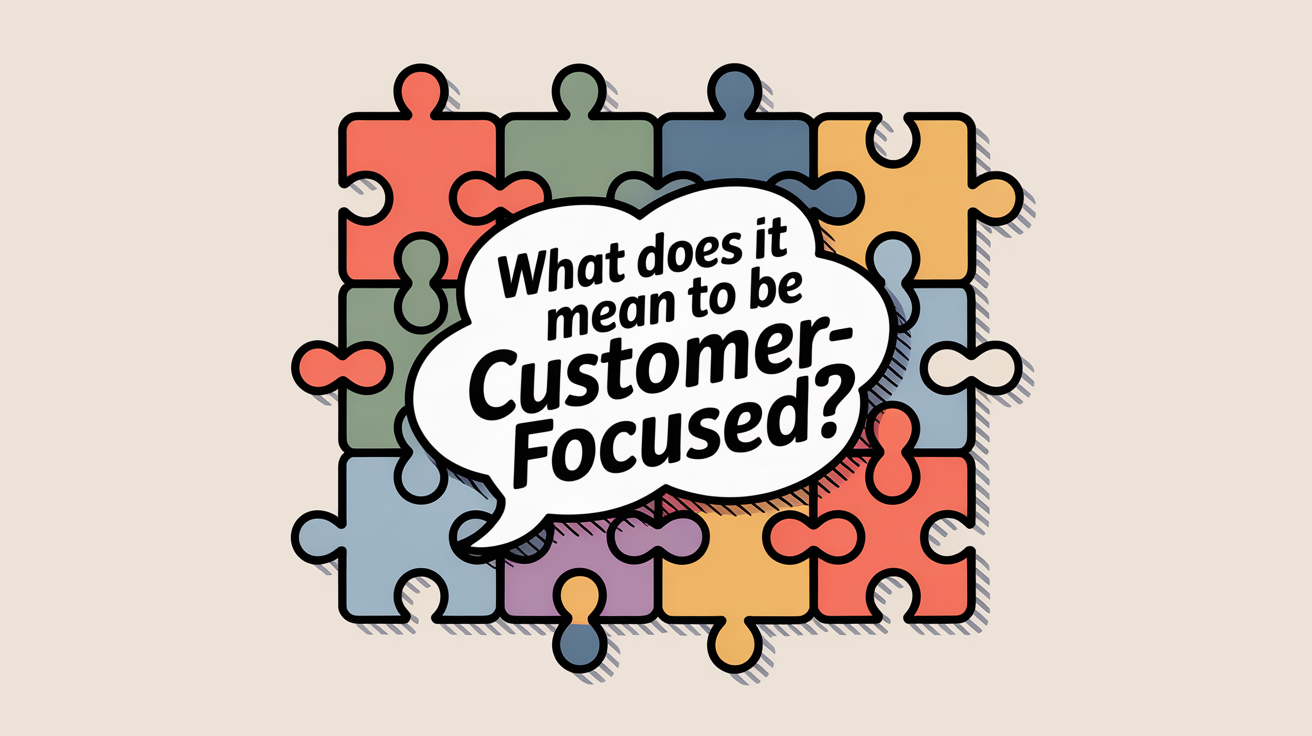
What Does It Mean to Be Customer-Focused? (2025)
Discuss with AI
Get instant insights and ask questions about this topic with AI assistants.
💡 Pro tip: All options include context about this blog post. Feel free to modify the prompt to ask more specific questions!
TL;DR: Being customer-focused means every business decision starts with "What's best for the customer?" Companies that master this approach see 60% higher profits, while 57% of customers will switch after just one bad experience. It's not just about friendly service. It's a complete mindset that transforms your products, support, and growth strategy into a customer-winning machine.
Being customer-focused means putting your customers' needs at the heart of everything your business does. It's a strategy and culture where every decision (from product development to support policies) is guided by one essential question: "What's best for the customer?"
A customer-focused company strives to deeply understand its customers, deliver exceptional experiences, and build long-term relationships. This goes far beyond having a friendly support team. It's a mindset that permeates the entire organization, influencing how you communicate, solve problems, and grow your business.
So why does this matter more than ever in 2025? Because customer expectations have skyrocketed. Research shows that 89% of businesses now compete primarily on customer experience design, leaving product and price as secondary factors. Customers have endless options at their fingertips, and they won't hesitate to switch brands after a poor interaction.
The numbers tell a stark story: studies show that 57% of consumers will walk away after a single bad experience, and the cost of losing them is enormous. On the flip side, companies that get customer focus right reap huge benefits. Research indicates that customer-centric organizations are 60% more profitable than those that aren't focused on customers.
In short, putting customers first isn't just a nice slogan. It's a make-or-break strategy for sustainable growth.
Customer focus means analyzing every aspect of your business through the lens of the customer. It's an approach where enhancing customer satisfaction and delivering value take precedence over internal agendas.
Customer focus is the lens by which you analyze all your interactions with your customers… a core value to who you want to be as a company and how you want your customers to feel about you.
Customer needs come first: Decisions start with what customers want to achieve or what problems they need solved, rather than what's easiest for the company. Customer focus is a business approach that keeps your customers' needs, preferences and satisfaction at the center of your strategies and operations.
Instead of pushing products and then finding buyers, you identify customer pain points and build solutions for them. A software company might conduct extensive user research and discover its customers struggle with collaboration, leading the team to add real-time collaboration features to address that specific need.
It's enterprise-wide, not siloed: Being customer-focused isn't just a concern for front-line staff or the customer service department. A truly customer-focused organization breaks down silos so that every team (marketing, sales, product, support, etc.) aligns their goals with delivering customer value.
This means everyone in the company, from the CEO to an intern, understands how their work impacts the customer. Leading companies connect their entire organization through customer-centric values, ensuring every employee, not just customer service reps, is empowered to put customers first.
Critical insight: The choice between reactive customer service and proactive customer engagement will determine whether your business scales smoothly or struggles with constant firefighting.
Long-term relationships over short-term gains: A customer-focused mindset prioritizes earning customer loyalty over squeezing out one more sale. This often means thinking from the customer's point of view and even saying "no" to certain sales if they're not right for the customer in the long run.
Customer-focused companies try to understand what customers truly need, which may differ from what they say they want. The goal is to provide real solutions and a positive experience over time, not just a quick fix or upsell that isn't in the customer's best interest.
Proactive, not just reactive: Being customer-focused means you don't wait for customers to complain about an issue. You anticipate needs and address them in advance whenever possible.
It's the difference between reactively responding to support tickets versus proactively reaching out with a fix or a personalized recommendation. A customer-focused company studies customer behavior and feedback continuously, so it can deliver what customers might not even know they want yet.
Amazon founder Jeff Bezos captured this ethos with his description of Amazon's strategy: "customer centricity, putting the customer at the center of everything Amazon does." In practice, Amazon invests heavily in things like one-click ordering, fast delivery, and personalized product suggestions, all anticipating customer desires before they even ask.
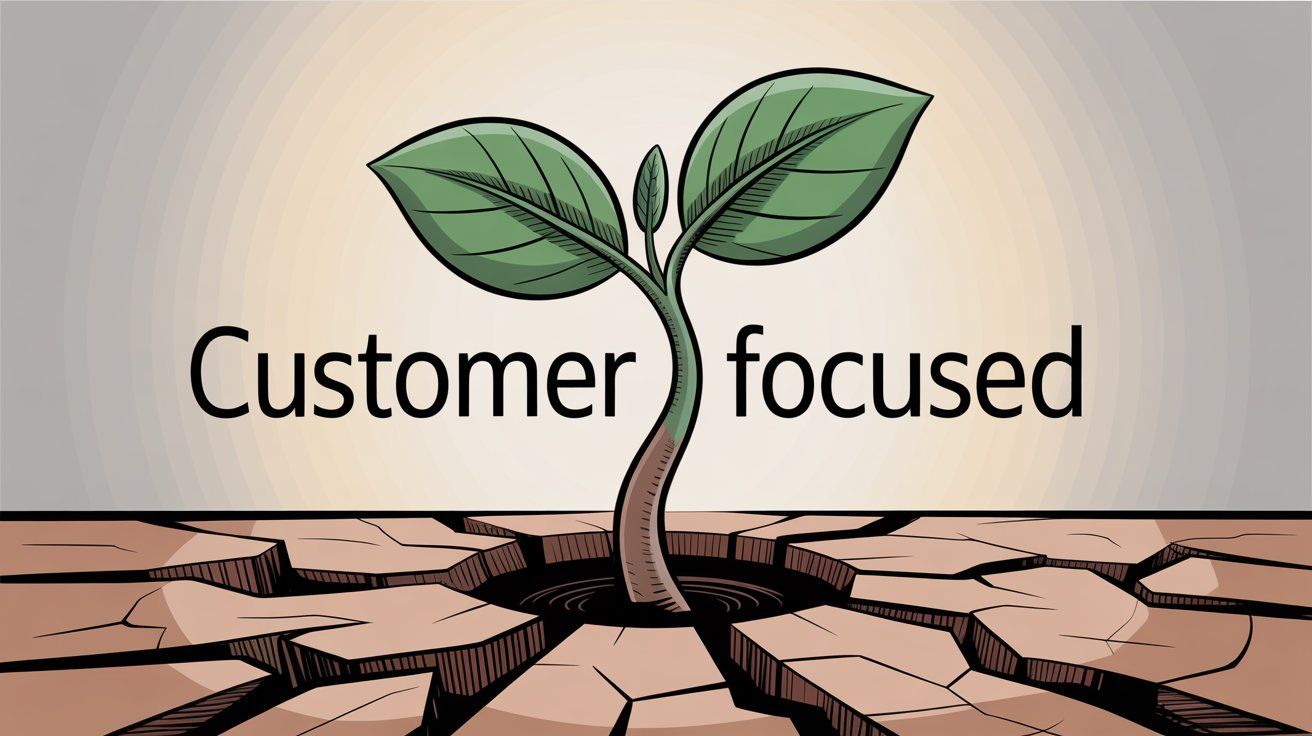
Being customer-focused has always been good business, but today it's absolutely critical. You want to know why focusing on customers is the key to survival and success in the current market?
Nearly 9 in 10 companies now compete mainly on customer experience rather than on unique products or pricing. In an era of abundant choices and informed consumers, how you make customers feel can determine whether you win or lose the market.
Research findings show that 73% of consumers rank customer experience as an important factor in purchasing decisions, right behind price and quality. Great service and smooth experiences aren't just "nice-to-have." They directly drive revenue.
The digital, on-demand age has conditioned people to expect speed, personalization, and consistency from every brand, big or small.
Consider these statistics:
• 90% of consumers say an immediate response from a company is important or very important when they have a customer service question
• 73% of consumers expect companies to understand their unique needs and expectations
• 57% will switch to a competitor after a single bad experience
• 86% will leave after two poor experiences
There is essentially zero margin for error. A customer-focused approach helps you consistently meet these expectations by tailoring experiences and fixing problems before they escalate.
Customer Expectation | Business Impact | Solution Required |
|---|---|---|
Immediate responses | 90% consider this critical | |
Personalized experience | 73% expect unique treatment | Data-driven customization |
Zero tolerance for errors | 57% leave after one bad experience |
Focusing on customers' happiness pays off in retention. Satisfied customers stick around, spend more, and refer others. It's far cheaper to retain an existing customer than to acquire a new one.
Research shows that returning customers spend 67% more than new ones on average. By listening to customers and delivering what they need, you can keep them coming back.
One financial services company reduced customer defections by 16% simply by aligning teams and processes more closely to customer satisfaction metrics. Customers who feel valued are more loyal, and loyalty directly boosts your bottom line.
In the social media age, every customer's voice is amplified. A customer-focused business that consistently delights people will generate positive reviews, referrals, and user-generated buzz.
Studies show 77% of customers would recommend a brand to a friend after a single positive experience. On the other hand, one bad viral complaint can dent your reputation overnight.
Companies renowned for customer focus (think Apple's fanatic user following or Trader Joe's cult loyalty) achieve that status largely through word-of-mouth from happy customers. A strong customer-centric reputation becomes a durable competitive moat.
When products are similar and innovation cycles are short, how you sell and support can matter more than what you sell. Focusing on customer needs helps you spot opportunities competitors miss and differentiate on service quality.
Many retailers sell coffee, but Starbucks pulled ahead by observing customers' routines (people rushing to work) and introducing mobile ordering to save them time. They also maintained cafe service for those who wanted a relaxing experience, covering both needs.
This customer-informed innovation gave Starbucks an edge. Generally, companies that prioritize customer focus can charge premium prices or earn more loyalty, because customers reward the companies that treat them best. Research indicates 86% of consumers are willing to pay more for a great experience.
In short: customer focus equals competitive edge.
Transforming into a customer-focused company doesn't happen overnight. It requires a deliberate strategy and often a cultural shift. The good news: any business can become more customer-centric by implementing the right practices consistently.
You can't be customer-focused if you don't actually know what your customers want or struggle with. The first step is developing a rich, research-based understanding of your target customers.
Start by actively engaging in market research and customer listening. Use tools like surveys, focus groups, interviews, and social media monitoring to gather insights. Analyze your customer support tickets and sales inquiries. What questions or complaints come up most?
Mine your reviews and online comments for recurring themes. If you have data analytics, look at usage patterns to see where customers encounter friction. The goal is to build a detailed picture of who your customers are and what they need from you.
Pro tip: Don't assume you know your customers' priorities. Ask them and observe them. Even simple steps like sending a follow-up survey after a purchase, or regularly calling a few customers to hear their experiences, can uncover golden feedback.
Make this an ongoing habit, not a one-time project. Customer preferences evolve, so continuous research keeps you aligned with what matters to them.
By deeply understanding your customers, you equip your business to deliver solutions that truly resonate. You'll also spot opportunities for innovation that a less customer-attuned competitor might miss.
Becoming customer-focused often requires a cultural shift, especially if your company has traditionally been product-centric or internally driven. Culture change starts from the top.
Leadership must clearly communicate that customer satisfaction and loyalty are top priorities, and model that mindset in decisions. When the C-suite consistently asks "How will this impact customers?" it sets the tone for the whole organization.
To instill a customer-centric culture, weave customer focus into your core values, hiring, training, and incentives. Emphasize empathy and customer advocacy in your employee onboarding. Teach every department how to connect their work to customer outcomes.
For example, educate your finance team on how billing errors create customer frustration, or explain to engineers how a slow app affects user satisfaction. This helps all employees see the human side of the metrics they deal with.
Cross-functional collaboration is also key. Break down silos that hinder a seamless customer experience. Customers see one brand, so your teams must work in concert to serve that customer.
Important: Empower employees to go the extra mile for customers. Rigid policies or bureaucracy that prevent staff from helping a customer are the enemy of customer focus.
Empower employees to go the extra mile for customers. Frontline teams should have the authority to do what's right, whether it's expediting a solution, offering a courtesy credit, or bending a rule when it makes sense.
Famous customer-centric companies empower their people: Zappos famously allows support reps to spend as much time as needed with a customer to resolve an issue (one call went on for 10 hours!). This level of trust in employees sends a clear message that customer happiness outweighs arbitrary efficiency metrics.
Finally, reinforce the culture by recognizing and rewarding customer-focused behavior. Consider linking part of bonuses or evaluations to customer satisfaction scores or customer retention rates. Celebrate team members who receive glowing customer feedback or who proactively solved a tricky customer problem.
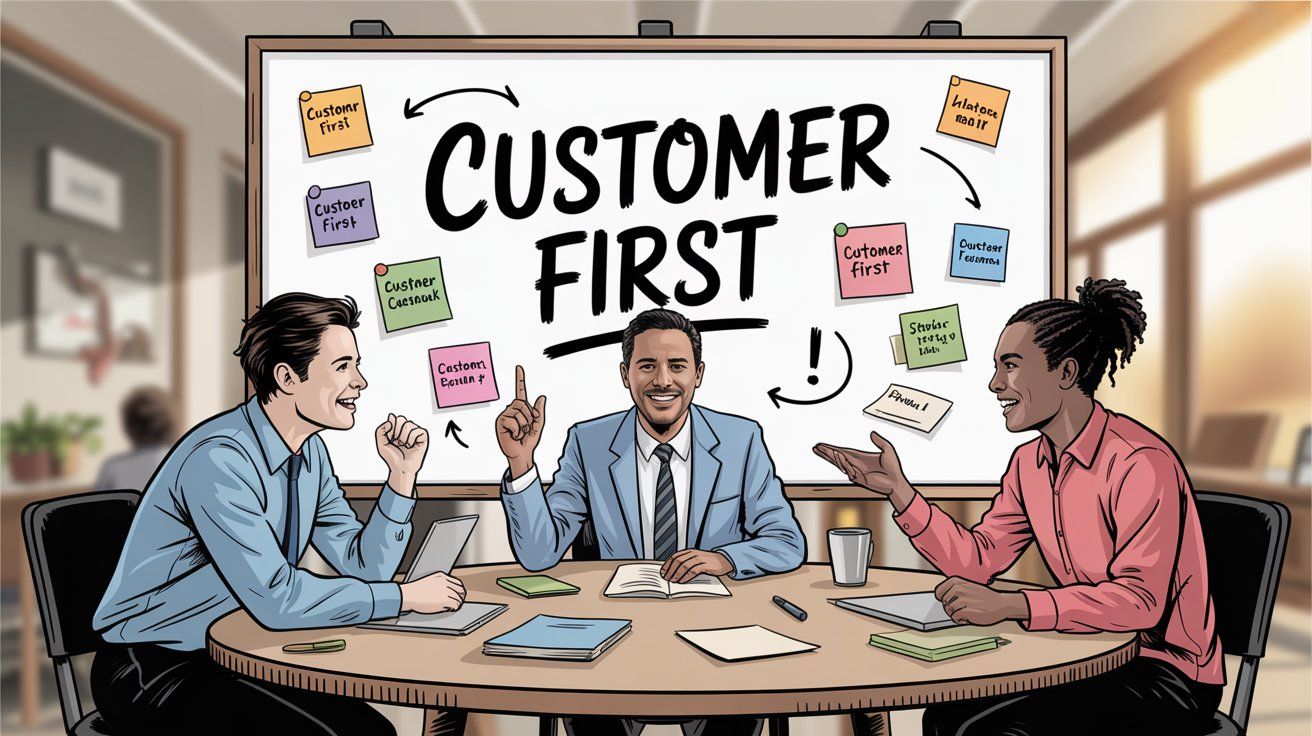
Being customer-focused is an ongoing conversation, not a guessing game. Regularly collecting customer feedback is how you keep a pulse on customer satisfaction and spot areas to improve.
The best companies make it easy for customers to voice their opinions and they actively solicit that input through multiple channels.
There are many ways to gather feedback, so use a combination:
→ Post-purchase surveys and NPS polls
→ Customer interviews and usability tests
→ Feedback forms on your website
→ Social media listening and monitoring
The key is to create loops where customer input flows into your team on a continual basis. For instance, you might send an email survey 24 hours after a product is delivered to gauge the customer's initial satisfaction.
Don't just collect feedback. Close the loop by acting on it and letting customers know. If customers see that you implement changes based on their suggestions, it builds trust and loyalty.
For example, if several users request a new feature, acknowledge it and consider adding it to your roadmap. If feedback reveals frustration with your checkout process, bring it to your UX team and fix the pain point. Then, inform customers: "You spoke, the company listened. Here's what's been improved."
This shows that their voice truly matters. Some companies publicly share what they're hearing and doing (like a "Product Changelog" or "Customer Wishes Granted" blog).
Research shows that companies that gather feedback from both customers and internal teams drive improvements consistently. As a result, they maintain customer satisfaction ratings above 93%, because they iterate their service based on what users tell them.
Understanding your customers through feedback is the bedrock of sustainable growth. It's how you uncover unmet needs, fix issues before they become crises, and evolve with your customers over time.
Also, prioritize and triage feedback wisely. Not every single request can be fulfilled, and sometimes customers ask for conflicting things. A customer-focused approach involves analyzing feedback trends to identify what changes will benefit a large segment of customers or align with your long-term vision.
No one wants to feel like just an anonymous account number in a database. Being customer-focused means treating customers as individuals whenever possible, tailoring your communications, offers, and experience to fit their context.
Personalization at scale has become a major differentiator. 73% of consumers expect companies to understand their unique needs and personalize interactions accordingly.
And not only do they expect it, but they respond to it: businesses that excel at personalization see significantly higher engagement and sales (up to 40% more revenue according to McKinsey).
How can you personalize effectively?
Address customers by name and reference their history: Whether in marketing emails, chat conversations, or support calls, use the information you have (purchase history, past issues, preferences) to tailor the interaction.
A simple example: an e-commerce site sending a shipping notification might say "Hi Alex, your order of 2 pairs of size 9 shoes is on its way" instead of a generic "Dear Customer, your order has shipped." The latter feels robotic; the former feels like personalized service.
Segment and target communications: Rather than blasting the same message to everyone, segment your customer base into meaningful groups (by behavior, interests, lifecycle stage, etc.). Then provide content or offers that speak to each segment's needs.
For instance, a SaaS company might send different onboarding tips to a tech-savvy user vs. a non-technical user. Or a retailer could promote winter jackets to customers in cold climates and raincoats to those in rainy regions.
Use AI and automation for recommendations: Modern AI tools can analyze customer data to provide personalized recommendations at scale, from product suggestions ("You might also like…") to content ("Since you enjoyed this article, here's another relevant read").
Netflix is a classic example: by analyzing each user's viewing habits, they curate a custom home page of shows and movies for that user. This level of personalization makes customers feel understood and tends to increase engagement (Netflix's model keeps people watching more, because the suggestions align with their tastes).
The overarching idea is to make each customer feel valued as an individual. Little touches add up, like a hotel remembering your previous room preference, or Spotify creating a "Discover Weekly" playlist just for you.
It shows the company is paying attention and cares about your preferences. Research shows this strengthens the emotional connection between the customer and your brand.
But personalization must be done thoughtfully. Customers are also sensitive about privacy. Always use data ethically and transparently. Personalization should feel helpful, not creepy.
When executed well, personalization can dramatically boost satisfaction. One survey found 77% of consumers have chosen, recommended, or paid more for a brand that provides a personalized experience. By tailoring experiences, you're telling customers: "You're seen. You're not just a number."
Speed and convenience are core to customer focus, particularly when customers need help. If a customer has a question or a problem, a customer-focused company leaps into action to assist as quickly as possible.
In practice, this means minimizing wait times, offering help on the channels customers prefer, and even solving issues before customers contact you.
Start with responsiveness. As mentioned, 90% of consumers rate an immediate response as important in customer service. While "immediate" might be hard to achieve 100% of the time, the expectation is clear: faster is better.
Examine your support processes. Are there bottlenecks causing delays? Invest in training and staffing to ensure inquiries don't sit unanswered.
Many companies now use a combination of AI chatbots and human agents to achieve 24/7 coverage. AI-powered chatbots can handle common questions instantly (think order status, basic troubleshooting, FAQs) so customers get answers in seconds, any time of day.
This also frees up human agents to focus on more complex issues where a personal touch is needed. The result is a win for both sides: customers get quick help, and agents aren't overwhelmed by simple repetitive queries.
Being customer-focused also means offering support in the channels and languages your customers prefer. Meet them where they are. If your customers are active on WhatsApp, Instagram DMs, or Facebook Messenger, consider using those as support channels.
This is where tools like Spur become incredibly valuable. Spur provides a unified messaging platform that brings together WhatsApp, Instagram, Facebook, and live chat into one shared inbox. This means your team can respond quickly across all channels without juggling multiple platforms.
Four Seasons Hotels is a great example: they provide guests with seamless, conversational support in their native language across 10+ channels (from SMS to social media) all unified through one system. Guests can choose the channel most convenient for them to request services or ask questions.
In today's omnichannel world, consistency across channels is vital. At least 75% of consumers expect a consistent experience wherever they engage (web, phone, chat, in-store). Ensuring your messaging and help are integrated prevents customers from having to repeat themselves or getting conflicting answers.
Beyond reacting quickly, proactive support is a hallmark of a truly customer-focused approach. This involves anticipating needs and addressing them preemptively.
Some ways to do this:
① Send customers helpful info before they ask, like a setup guide immediately after a product purchase, or outage alerts with an apology and ETA for fix (so they're not left wondering)
② Use automation to check in on customers at key moments. If your system detects that a user has been struggling to complete a certain task, trigger a friendly message: "Need any help with that?"
③ Analyze past support tickets for common issues and improve your product or documentation to prevent those issues altogether
④ For high-value clients, assign account managers or use monitoring tools to catch signs of dissatisfaction early and reach out proactively
According to research, by 2025 40% of customer service organizations will have adopted proactive outreach strategies to resolve issues before customers contact them. This trend is driven by the clear payoff: proactive engagement increases trust and reduces inbound complaints.
A quick case in point: an e-commerce company implemented proactive SMS notifications that inform customers of shipping delays before the expected delivery date, along with a discount coupon as an apology. This simple step turned what could have been a flood of angry "Where's my package?" calls into gratitude for the transparency and a second chance for the company.
Don't make customers wait or jump through hoops to get help. Fast, convenient, and anticipatory service is central to customer focus. If you consistently save your customers time and effort, they will remember it.
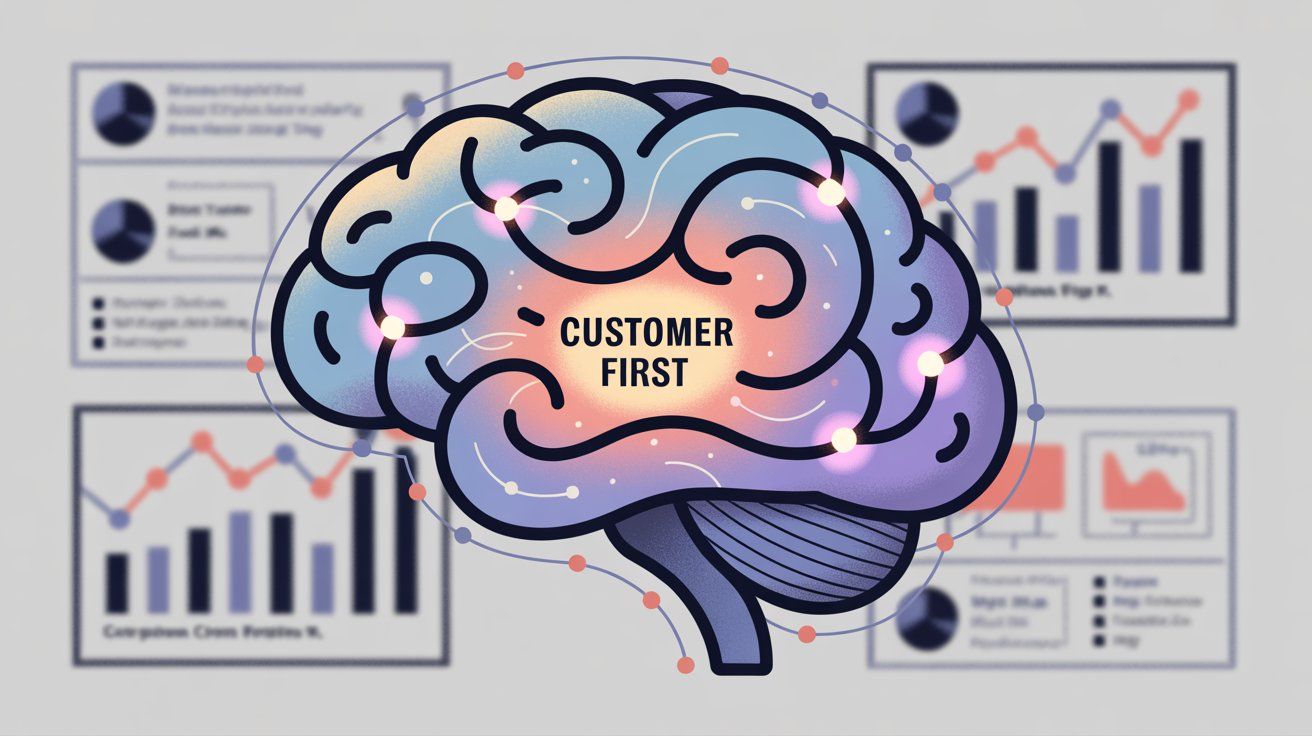
Even in the age of AI, your people remain one of the most important assets in delivering a customer-focused experience. Happy, empowered employees translate into happy customers. So, a key principle is to give your team the training, tools, and authority they need to put customers first.
Training is foundational. Invest in comprehensive onboarding and continuous learning for anyone who deals with customers (sales reps, support agents, customer success managers, even technicians and delivery personnel).
Focus training not only on products and policies, but also on soft skills like empathy, listening, and problem-solving. Teach employees what great customer service looks like and how to handle various scenarios. Role-play difficult situations so they build confidence.
Also train them on the why: share customer success stories and pain points so they emotionally connect with the importance of their role in the customer's experience. When employees understand the impact of customer focus on both the customer's life and the business's success, they are more motivated to deliver their best.
Empowerment means giving frontline staff enough autonomy to truly help customers without constantly needing supervisor approval. Strict scripts or policies can hinder genuine service. Instead, provide guidelines and let employees use judgment within reasonable bounds.
For example, allow support agents a modest budget to offer freebies or credits to resolve customer complaints on the spot, if warranted. Or empower retail employees to make an exchange or return happen even if it's a few days past policy, when it's clearly the right thing for customer goodwill.
These may seem like small gestures, but they prevent situations where an employee has to tell a customer "I'm sorry, I'm not allowed to do that," which is the opposite of a customer-centric vibe.
Providing the right tools is equally important. Equip your team with modern customer service technology that makes their jobs easier and gives them a 360° view of the customer.
Nothing frustrates an employee (or a customer) more than systems that are slow, disjointed, or don't have the info needed. Consider using a unified customer communication platform or CRM that pulls in data from all departments (sales, support, billing, etc.) so that a customer only needs to tell their story once.
Currently, only about 22% of organizations have fully unified customer data across channels, which means many support agents still struggle with incomplete context.
This is where platforms like Spur excel. Spur's unified customer communication management system brings together all customer messages from WhatsApp, Instagram, Facebook, and live chat into one interface. When a customer contacts you, your team can immediately see their history: past purchases, previous issues, preferences, and so on.
This context enables faster, more personalized service and "creates a single source of truth for every customer-facing message," eliminating conflicting info and confusion.
Another tool angle is AI assistance for agents. Far from replacing humans, AI can augment your team's capabilities. For example, AI-driven "agent assist" tools can listen to calls or live chats and in real time suggest helpful knowledge base articles or next steps to the agent.
This can improve accuracy and speed, especially for new team members who are still learning. AI can also automate after-call summaries or handle routine workflows, freeing your staff to focus on the human touch only they can provide.
Finally, foster a supportive environment. Empowered teams need to know leadership has their back when they make customer-centric decisions. If an employee uses their discretion to appease an unhappy customer in a reasonable way, applaud it rather than second-guessing the cost.
In short, a customer-focused business invests in its people. With proper training, authority, and tools, your team can turn a merely "okay" customer interaction into an outstanding one.
Remember, to the customer, your employees are the company. A friendly, well-equipped, and empowered employee can humanize your brand and build trust that no marketing campaign can replicate.

There's a saying in business: "What gets measured gets managed." To truly ingrain customer focus, you need to track metrics that reflect customer happiness and success, and use those metrics to guide decisions.
Too many companies only measure internal efficiency or sales targets, but forget to measure whether their customers are actually satisfied. A customer-focused company treats metrics like CSAT, NPS, and customer lifetime value as importantly as revenue or profit.
Some key customer-centric metrics and how to use them:
Metric | What It Measures | Why It Matters |
|---|---|---|
CSAT (Customer Satisfaction) | Post-interaction experience ratings | Quick pulse on expectation fulfillment |
NPS (Net Promoter Score) | Likelihood to recommend (0-10 scale) | Overall barometer of loyalty and sentiment |
Customer Retention Rate | Percentage who stay vs. leave | Direct indicator of relationship strength |
CLV (Customer Lifetime Value) | Total revenue per customer over time | Long-term relationship value focus |
First Contact Resolution | Issues solved on first try | Service efficiency and customer effort |
Response Times | Speed of initial customer contact response | Meets modern speed expectations |
Customer Satisfaction (CSAT): Often measured via post-interaction surveys asking customers to rate their experience. CSAT gives a quick pulse on whether you're meeting customers' expectations in specific interactions. Track CSAT over time and break it down by channel, team, or product line to identify strengths and weaknesses.
Net Promoter Score (NPS): This measures loyalty by asking customers "How likely are you to recommend us to a friend?" on a 0-10 scale. NPS is a great overall barometer of customer sentiment and loyalty.
Slack, for example, prioritized metrics like NPS and CES (Customer Effort Score) as key measures of success, rather than just user counts. And it helped them cultivate millions of loyal daily users by focusing on making those users happy.
Customer Retention Rate/Churn Rate: Simply, what percentage of customers stay with you vs. leave (over a given time frame). A rising churn rate is a red flag that customers are unhappy or finding better alternatives. A high retention rate often signals strong customer relationships and product-market fit.
The key is not to drown in metrics, but to choose a handful of core customer-focused KPIs and regularly review them at the highest levels. Tie these metrics to team goals and even individual performance where appropriate.
By institutionalizing these measures, you signal that customer satisfaction is as important as hitting a sales quota.
It's also crucial to close the loop from measurement to action. Numbers alone don't improve; you must interpret and act on them. If CSAT for your mobile app dropped this month, dig into why. If NPS is climbing, find out what you're doing right and double down on it.
With today's analytics tools, you can even monitor customer sentiment in real time. For instance, AI can predict customer satisfaction during live chats by analyzing the conversation tone. If a chat is going south, a supervisor can jump in or the agent can offer a special solution before the customer leaves unhappy.
The bottom line: Measure what matters to customers, not just what matters to accounting. By keeping a close eye on customer-centric metrics and holding your team accountable to them, you bake customer focus into the operational DNA of your business.
It ensures that you're not just claiming to be customer-oriented, but actually tracking and proving it with data, and constantly improving based on that data.
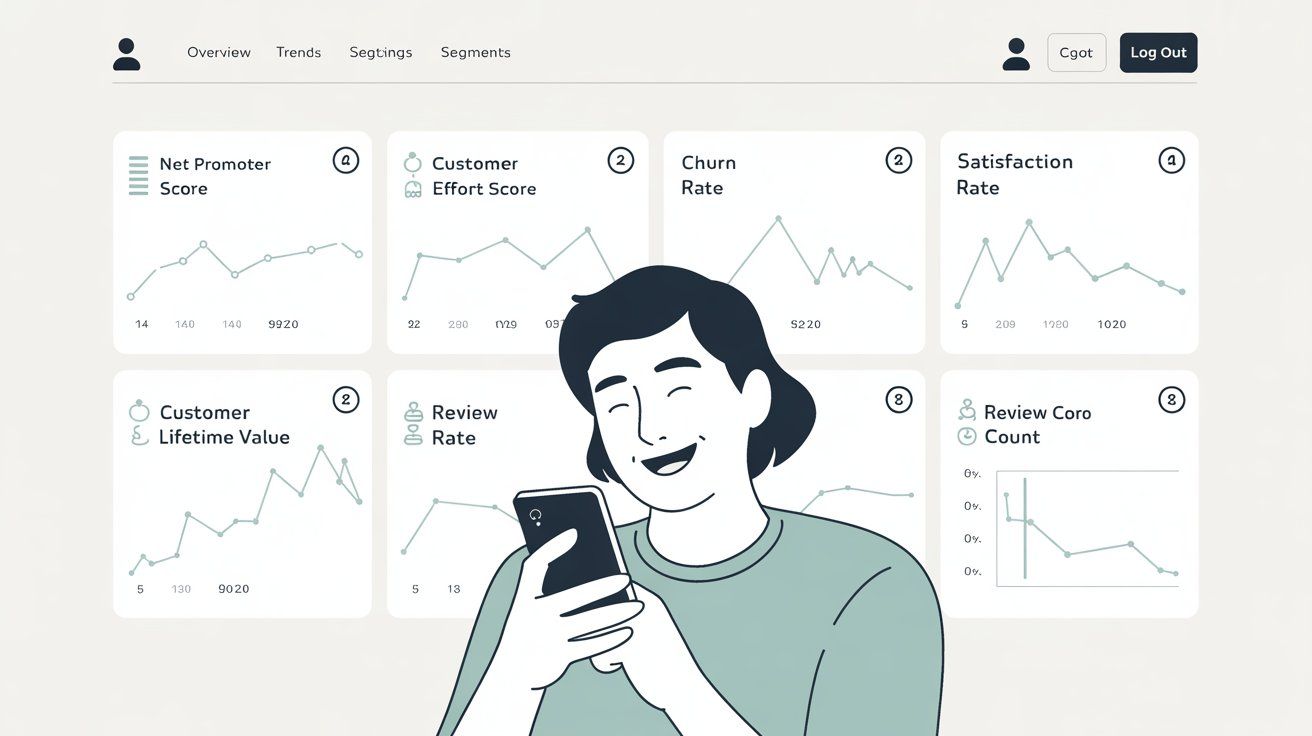
Sometimes it helps to see how theory translates into practice. Looking at standout companies known for their customer-focused philosophies shows what businesses can learn:
Online shoe retailer Zappos has become almost legendary for its customer service. The company's core value is to "deliver WOW through service," and it empowers employees to do whatever it takes to make customers happy.
Zappos famously has a 365-day return policy and free two-way shipping, making the purchasing experience risk-free. They even allow returns with no box or label needed by partnering with local Whole Foods drop-offs, reducing hassle for customers.
Stories abound of Zappos reps spending hours on the phone with customers, sending hand-written thank you notes, and even surprising customers with overnight upgrades to make sure shoes arrive before an event.
CEO Scott Schaefer summed it up: "Being a customer-first company is in Zappos' DNA… as customers' needs evolve, Zappos evolves with them to ensure they're exceeding expectations at every step."
The takeaway: Customer focus at Zappos means bending over backwards to deliver convenience, comfort, and a personal touch, forging intense loyalty (and lots of word-of-mouth advertising) in the process.
Amazon is often cited for its "customer obsession," which Jeff Bezos made the company's first leadership principle. What does that mean in practice?
Amazon relentlessly innovates to make shopping easier, faster, and cheaper for customers. Think about Amazon's one-click ordering, personalized recommendations, endless selection, and push for ever-faster delivery (Prime same-day, drones, etc.).
Those all started from asking, "How can we better serve what customers really want?" Amazon also empowers support staff to fix customer issues generously, known for hassle-free refunds or sending replacement items immediately if a package goes missing.
Bezos has said, "Amazon isn't competitor-obsessed, they're customer-obsessed… They start with what the customer needs and work backwards."
One concrete example: Amazon noticed people hate complicated checkout processes online, so they patented 1-Click checkout, an innovation purely to reduce customer effort. They identified delivery time anxiety as a pain point, so they built out a world-class logistics network to offer reliable two-day or faster shipping.
Amazon's growth into a trillion-dollar empire is largely due to its intense focus on removing customer pain points and delivering ever-greater value, often before customers even realize they want it.
Global coffee chain Starbucks shows customer focus in how it adapts its service to fit customers' daily habits. A few years ago, Starbucks noticed many customers were in a rush in the mornings and disliked waiting in line.
In response, they rolled out Mobile Order & Pay through their app, allowing customers to order and pay ahead so they can simply pick up and go. This was a direct answer to a customer need for speed.
At the same time, Starbucks recognized that not all customers want a rushed experience (some come to relax or work and enjoy the cafe atmosphere). They kept the traditional counter service alongside mobile ordering, essentially giving customers the choice.
Plus, Starbucks built one of the most successful loyalty programs (Starbucks Rewards) which rewards frequent customers with freebies and personalized offers, as a way to say thank you to their regulars.
The Starbucks lesson is being attentive to how customers live and what they value, whether it's speed, convenience, recognition, or comfort. And then evolving the experience to meet those expectations.
Four Seasons Hotels redefined luxury hospitality by focusing on personalized, human-centric service. They understand that luxury travelers expect not just beautiful properties but exceptional service experiences.
Four Seasons empowers its staff at all levels to do whatever it takes to make a guest's stay memorable. There are tales of concierges achieving near-miracles, like finding a lost toy for a child or arranging last-minute special meals.
One way Four Seasons stays customer-focused is by offering high-touch support through whichever communication channel the guest prefers. Four Seasons enables guests to reach out via phone, email, text, or social messaging (like WhatsApp or WeChat) and get a seamless response.
Guests can request a spa booking via a quick text message in their native language, for instance, and get it confirmed without ever picking up the room phone. All these interactions are unified, so if a guest texts in a request and later calls, the next agent already knows the prior conversation.
This makes the customer feel recognized and saves them from re-explaining. A big deal in luxury where expectations are high.
Each of these examples shows a common thread: deep understanding of customer needs plus willingness to adapt the business around those needs. Whether it's Zappos making returns effortless, Amazon prioritizing customer convenience above short-term profit, Starbucks rethinking store operations for speed, or Four Seasons meeting customers wherever they are, these brands thrive by obsessing over their customers.
Any business can draw inspiration from them and ask, "What would a truly customer-focused approach look like for their customers?"
Being customer-focused in 2025 requires the right technology foundation. This is where Spur becomes an essential partner for businesses serious about putting customers first.
The Challenge: Modern customers interact with brands across multiple channels (WhatsApp, Instagram, Facebook, live chat, and email). Managing these conversations separately creates delays, inconsistencies, and frustrated customers who have to repeat themselves.
Spur's Solution: A unified AI messaging platform that brings all customer conversations into one shared inbox, powered by actionable AI agents that can actually solve problems, not just answer questions.
Actionable AI, Not Just Chatbots: While basic chatbots can only answer simple questions, Spur's AI agents can take real actions. They can track orders, update customer records, book appointments, and integrate with your existing systems. This means customers get actual solutions, not just information.
Knowledge Base Training: Unlike tools that rely on generic responses, Spur trains its AI on your specific business knowledge. Your customers get accurate, personalized answers based on your products, policies, and procedures.
Multi-Channel Unified Experience: Customers can start a conversation on Instagram, continue it on WhatsApp, and finish it via live chat, all while your team maintains complete context. This unified approach eliminates the frustration of customers having to repeat their story multiple times.
Proactive Customer Engagement: Set up automated flows for abandoned cart recovery, order updates, and follow-up surveys. Spur helps you anticipate customer needs and address them before customers even have to ask.
Real-Time Customer Insights: Monitor conversation sentiment and satisfaction in real-time. When a customer interaction starts going poorly, your team can intervene immediately to turn the situation around.
Companies using Spur to improve their customer focus see impressive results:
• Eves & Gray achieved 88.75x ROI in 24 hours with targeted WhatsApp messaging
• Muffynn generated 73x ROI on a targeted broadcast campaign
• Libas converted 6% of Instagram Live viewers into orders using comment automation
The bottom line: When you make customer interactions faster, more personalized, and more helpful, customers respond with loyalty and increased spending.
Spur helps you treat customers like the center of your universe by giving you the tools to deliver exceptional experiences across every touchpoint. It's customer focus, powered by modern technology.
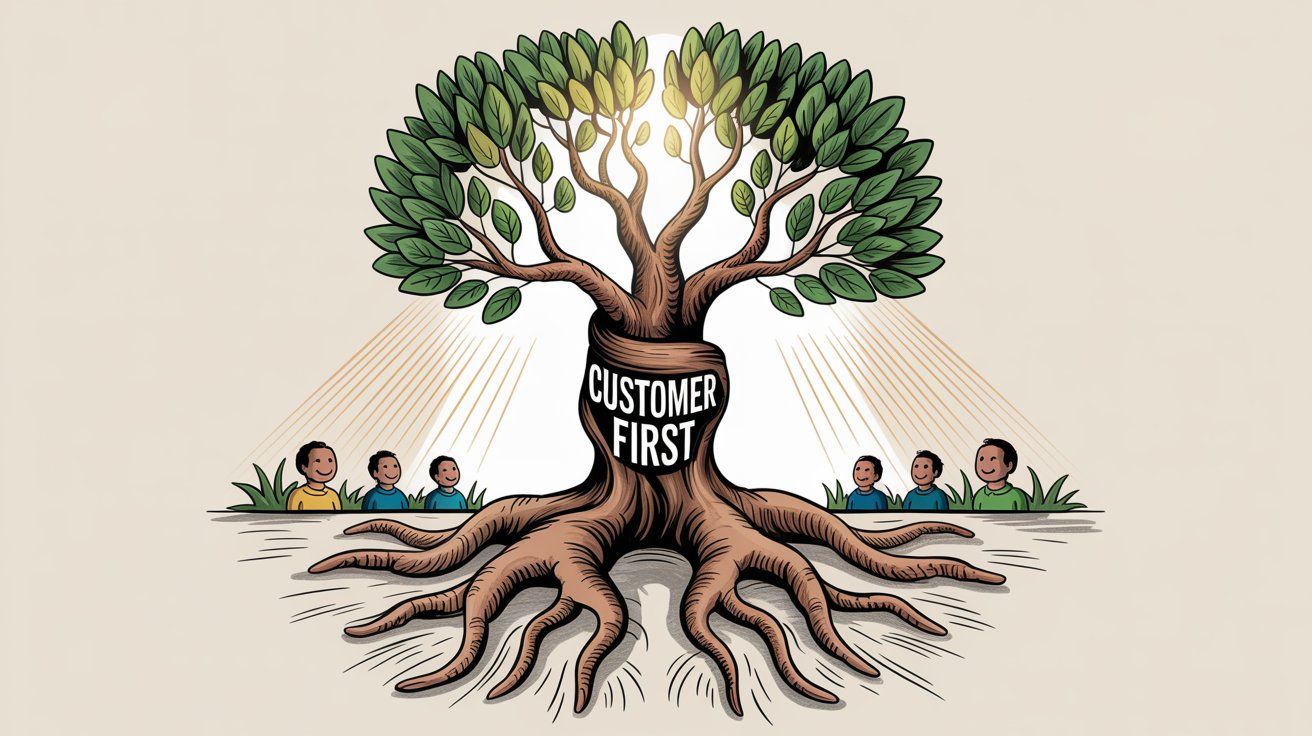
Question | Key Point | Spur Solution |
|---|---|---|
What's the difference between customer service and being customer-focused? | Customer service is reactive; customer focus is proactive across the entire company | Unified platform for company-wide customer engagement |
How do I measure if my business is truly customer-focused? | Track CSAT, NPS, retention, CLV, and operational metrics | Real-time sentiment monitoring and analytics |
Can small businesses compete with large companies on customer focus? | Yes, through agility, personal attention, and knowing customers by name | Affordable automation that maintains personal touch |
How long does it take to become customer-focused? | 6-18 months for culture change, but quick wins can start immediately | Immediate feedback collection and response improvement |
True customer focus actually increases profitability long-term. Customer-centric companies are 60% more profitable than those that aren't. While some customer-focused decisions might cost money upfront (like generous return policies), they build loyalty that drives repeat business and referrals. The key is balancing immediate costs with long-term customer value.
Start by explaining the "why." Share customer success stories and show how customer satisfaction directly impacts business success (and job security). Train employees on empathy and customer impact. Empower them with authority to help customers. Most importantly, tie performance reviews and bonuses to customer satisfaction metrics, not just sales or efficiency numbers.
The biggest mistake is treating customer focus as a project or initiative rather than a permanent cultural shift. Companies often implement new policies or systems but don't change the underlying mindset. Another common mistake is collecting customer feedback but not acting on it, which actually makes customers more frustrated than not asking at all.
Start small and focus on high-impact, low-cost improvements. Respond to customers faster, empower employees to solve problems on the spot, and ask for feedback regularly. Use technology to automate routine tasks so humans can focus on relationship building. Tools like Spur can help small teams manage multiple communication channels efficiently without hiring additional staff.
Technology should enhance human connection, not replace it. Use tools to unify customer data, automate routine responses, and provide faster service across multiple channels. Platforms like Spur help by centralizing all customer conversations and using AI to handle simple queries, freeing your team to focus on complex issues that require human expertise and empathy.
Document your customer-focused processes and values clearly so new employees understand them. Invest in systems that maintain personal touch at scale (like CRM systems that track individual preferences). Continue measuring customer satisfaction metrics and share results company-wide. Most importantly, keep leadership involved in customer interactions. Even CEOs should regularly talk to customers directly.
Being customer-focused isn't a one-time initiative or a nice-to-have philosophy. It's an ongoing commitment and fundamental way of doing business. It means continually asking "How will this decision impact our customers' experience?" and genuinely listening to the answer.
The evidence is overwhelming: companies that genuinely put customers first consistently outperform those that don't. Nearly all growth-leading firms emphasize customer experience as their primary competitive advantage, and for good reason.
To recap, being customer-focused means: knowing your customers deeply, building your culture around serving them, listening and adapting to feedback, personalizing and innovating to meet their expectations, responding quickly on their preferred channels, empowering your team to delight them, and measuring success by customer happiness.
It's not always easy. It often requires challenging the status quo and breaking some old habits. You might need to say no to short-term profits in favor of long-term relationships. You might need to empower employees in ways that feel risky. You might need to invest in systems and training that don't show immediate returns.
But the payoff is a resilient business that attracts devoted customers and stands out in a crowded market.
The age of the customer is here. Buyers have more power, more choices, and more information than ever. The only sustainable way to differentiate is to consistently deliver value and positive experiences for your customers.
The companies that do this will earn not just sales, but trust and loyalty. And there's nothing more valuable in business than a customer who genuinely loves your brand and tells others about it.
So ask yourself: Is your business truly customer-focused?
If the honest answer is "not yet," the strategies and examples in this guide can serve as your roadmap to get there. Start with small changes:
• Interview a few customers to understand their real needs
• Empower your frontline staff a bit more
• Fix one broken policy that frustrates customers
• Set up a system to collect feedback regularly
• Measure customer satisfaction alongside sales metrics
Create momentum around customer-centric thinking. Over time, you'll foster a culture where everyone's instinct is to consider the customer impact first.
Spur believes strongly in the power of customer focus. Spur's entire platform is designed to help businesses connect with customers in smarter, more meaningful ways through AI chatbots trained on your knowledge base and multi-channel unified messaging.
Spur has seen firsthand that when businesses make interactions easier, faster, and more personalized for customers, great things happen: response rates go up, satisfaction scores improve, and conversions increase.
It all comes down to treating customers like the center of your universe, because in reality, they are.
In the end, "customer-focused" means your success is tied to your customers' success. When you help them achieve their goals and delight them along the journey, they'll reward you with loyalty, advocacy, and sustained business growth.
That's the true meaning of being customer-focused. And it's a philosophy that can transform any business willing to embrace it.
